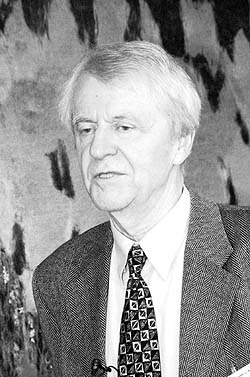Study of cross-sections of yttrium (n,xn) threshold reactions
Autor
| Chudoba Petr, Mgr. | Ústav jaderné fyziky AV ČR |
| Svoboda O. | Ústav jaderné fyziky AV ČR |
| Wagner Vladimír, RNDr. CSc. | Ústav jaderné fyziky AV ČR |
| Vrzalová Jitka, Ing. | Ústav jaderné fyziky AV ČR, SÚJV Dubna |
| Suchopár Martin, Ing. | Ústav jaderné fyziky AV ČR |
| Majerle Mitja , Mgr. Ph.D. | Ústav jaderné fyziky AV ČR |
| Štefánik Milan, Ing. | Ústav jaderné fyziky AV ČR |
| Kugler Andrej, RNDr. CSc. | Ústav jaderné fyziky AV ČR |
| et al. | různé instituce |
Rok
2014
Časopis
Proceedings of Science, Baldin ISHEPP XXII, 054
Web
Obsah
XXII International Baldin Seminar on High Energy Physics Problems, 2014, Dubna, Russia
Currently the development of the nuclear systems is heading to systems with fast neutrons instead of thermal ones. Such systems are mainly fast reactors of generation IV family and accelerator driven systems. Unfortunately the possibilities of monitoring fast neutrons are limited. One of the possible principles is to use activation detectors. It has shown up that yttrium is very good candidate to act as the activation detector of the fast neutrons. The advantages of yttrium are namely its (n,xn) threshold reactions and the fact that its only one naturally occurring isotope. To be possible to use yttrium as the activation detector it is necessary to know the cross-sections of the (n,xn) reactions sufficiently good. This condition is fulfilled only in case of the 89Y(n,2n)88Y reaction. For higher orders of reactions there are almost no experimental data.
For this reason a series of experiment were made using quasi mono-energetic neutron source based on the reaction of protons with 7Li target at Nuclear Physics Institute of ASCR in Rez. Special attention was paid to the 89Y(n,3n)87Y reaction. In this case the nuclei are produced both in the ground state and in the isomeric state. The half-lives are 79.8 hours for the ground state and 13.38 hours for the isomeric state. The isomeric state decays mainly through the gamma transition to the ground state. The beta decay of the isomeric state is within our accuracy negligible. The cross-sections of both cases of products were analyzed and compared with existing experimental data, calculated models and evaluated values.
Currently the development of the nuclear systems is heading to systems with fast neutrons instead of thermal ones. Such systems are mainly fast reactors of generation IV family and accelerator driven systems. Unfortunately the possibilities of monitoring fast neutrons are limited. One of the possible principles is to use activation detectors. It has shown up that yttrium is very good candidate to act as the activation detector of the fast neutrons. The advantages of yttrium are namely its (n,xn) threshold reactions and the fact that its only one naturally occurring isotope. To be possible to use yttrium as the activation detector it is necessary to know the cross-sections of the (n,xn) reactions sufficiently good. This condition is fulfilled only in case of the 89Y(n,2n)88Y reaction. For higher orders of reactions there are almost no experimental data.
For this reason a series of experiment were made using quasi mono-energetic neutron source based on the reaction of protons with 7Li target at Nuclear Physics Institute of ASCR in Rez. Special attention was paid to the 89Y(n,3n)87Y reaction. In this case the nuclei are produced both in the ground state and in the isomeric state. The half-lives are 79.8 hours for the ground state and 13.38 hours for the isomeric state. The isomeric state decays mainly through the gamma transition to the ground state. The beta decay of the isomeric state is within our accuracy negligible. The cross-sections of both cases of products were analyzed and compared with existing experimental data, calculated models and evaluated values.
Příklad citace článku:
P. Chudoba, O. Svoboda, V. Wagner, J. Vrzalová, M. Suchopár, M. Majerle, M. Štefánik, A. Kugler, . et al., "Study of cross-sections of yttrium (n,xn) threshold reactions", Proceedings of Science, Baldin ISHEPP XXII, 054 (2014)


 MINISTR ŠKOLSTVÍ KE SPOLUPRÁCI ČR S SÚJV
MINISTR ŠKOLSTVÍ KE SPOLUPRÁCI ČR S SÚJV INTEREST JINR, Wave 6
INTEREST JINR, Wave 6 Zemřel profesor Ivo Zvára
Zemřel profesor Ivo Zvára Výzva k podávání žádostí na projekty řešené ve spolupráci s SÚJV (Projekty 3+3)
Výzva k podávání žádostí na projekty řešené ve spolupráci s SÚJV (Projekty 3+3)  Výzva k podávání žádostí na Granty zplnomocněného představitele vlády ČR v SÚJV
Výzva k podávání žádostí na Granty zplnomocněného představitele vlády ČR v SÚJV Velvyslanec ČR v RF navštívil SÚJV
Velvyslanec ČR v RF navštívil SÚJV INTEREST JINR, Wave 5
INTEREST JINR, Wave 5 Ruské vízové centrum
Ruské vízové centrum Pracovní pobyty ČR - SÚJV 2022
Pracovní pobyty ČR - SÚJV 2022